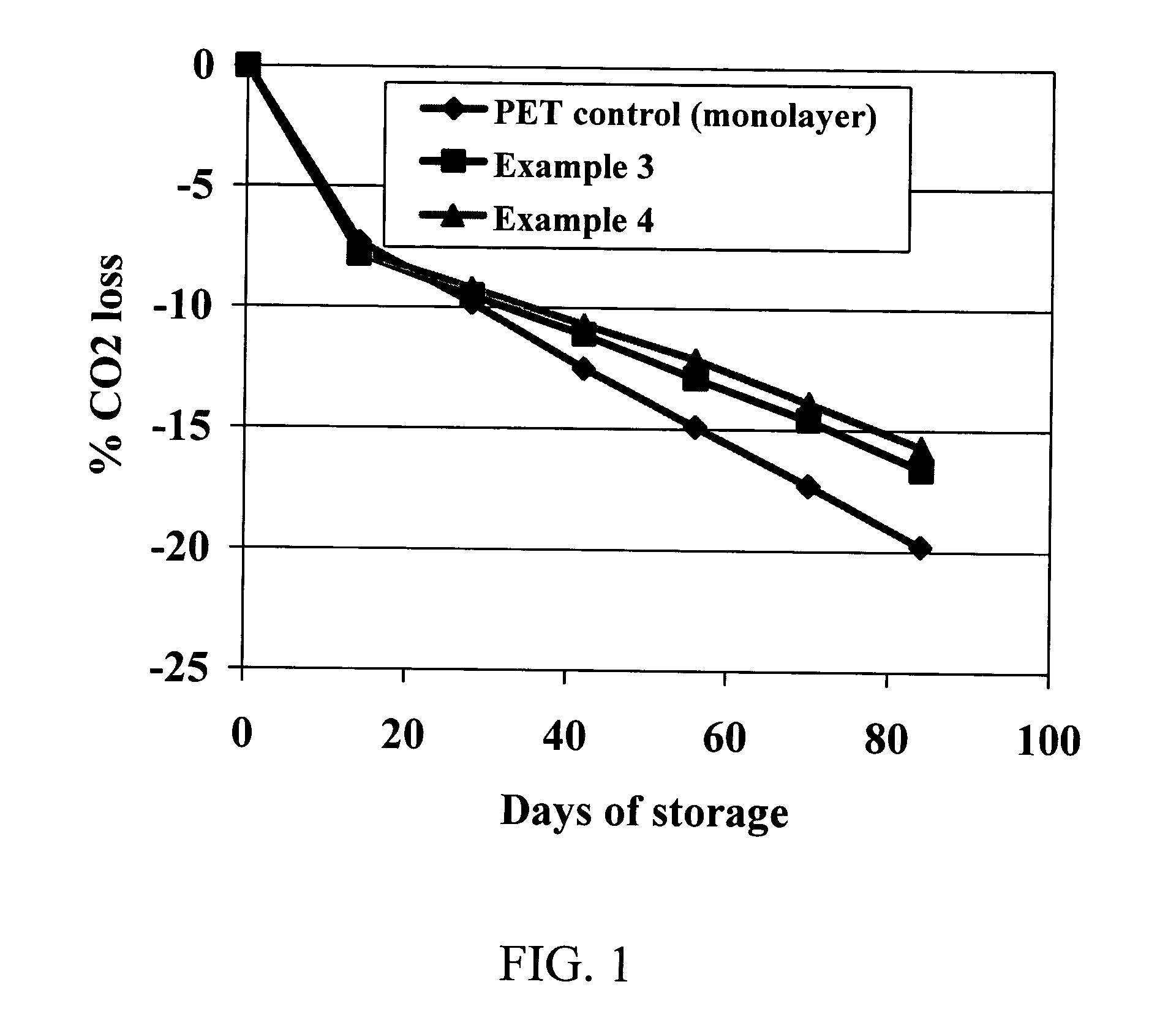Delamination-resistant, barrier polyamide compositions for 3-layer pet beverage bottles
a barrier polyamide and 3-layer technology, applied in the field of polyamide compositions, can solve the problems of deterioration of stored products, insufficient oxygen or carbon dioxide (cosub>2) gas barrier needed in monolayer pet bottles
- Summary
- Abstract
- Description
- Claims
- Application Information
AI Technical Summary
Problems solved by technology
Method used
Image
Examples
examples
The following process and characterizations steps were conducted for the following examples and comparative examples.
Process 1: Preparation of Polyamide Blend via Melt Blending in an Extruder
For the laboratory scale melt blending of the polyamides, a Leistritz 18-mm co-rotating twin screw extruder (TSE) equipped with a K-Tron volumetric feeder was utilized. The extruder had five separately heated mixing zones and a strand extrusion die all of which were maintained at around 250° to 260° C. Typically, a pellet mixture of a crystallizable aliphatic polyamide such PA-6 or PA-6 nanocomposite (Component A), an amorphous semi-aromatic polyamide PA-6I / 6T (Component B) and a crystallizable semi-aromatic polyamide such as PA-MXD6 (Component C) was pre-mixed at the desired ratio and the pellet blend was fed into the extruder hopper. The blend was then melt extruded at a screw speed of 150 rpm, a torque of 40-75%, a die pressure of 50-75 psi and a throughput rate of approximately 4.5 Kg / h...
examples 1-4
Examples 1-11 illustrate the effect of the inventive polyamide compositions.
Example 1 is a polyamide blend composition comprising of 30 wt % of a PA-6 Nanocomposite (Honeywell XA-2908 w / 2% nanoclay) as polyamide component A, 45 wt % of PA-MXD6 (Mitsubishi Gas Chemical's Nylon-MXD6-6007) as polyamide component B, 25 wt. % amorphous nylon PA-6I / 6T (Selar PA2072 from DuPont) as polyamide component C. The blend formulation was prepared via a melt blending process on an 18 mm Leistritz twin-screw extruder (Process 1) and pelletized into solid chips as usual. The pellets after drying were processed into a cast film (process 2). The CO2 barrier of this film was in the desirable range with a low CO2TR of 1.4 cc.mil / 100 in2 / day @ 80% RH. As outlined in Table 1, this composition exhibited a substantial improvement in the delamination resistance relative to the comparative examples 1-4, when it was used as the middle layer in the 3-layer PET bottles by coinjection stretch-blow molding (proc...
examples 6 , 7
Examples 6, 7, and 8 illustrate the use of PA-6 copolymers to achieve blend compositions with very slow to no crystallization tendency, while still retaining the desired barrier & glass transition temperatures. They were made and characterized similar to Examples 1-5.
The high delamination and haze levels in multilayer PET bottles derived from comparative examples 1 and 2 (Table 1) seem to indicate an inherent correlation between the high crystallization rates and crystallinities in these polyamides to the lack of adhesion and clarity between these materials and PET when processed into multilayer bottles even at as low as 3 to 5 w % loading levels.
The high haze levels in bottles containing layers of comparative example 3, comprising entirely of amorphous, semi-aromatic nylon, PA-6I / 6T led to substantial haze due to crazing and voiding in the nylon layer, when processed into multilayer PET bottles. The voiding and micro-cracking occurred primarily during the stretch blow molding pr...
PUM
| Property | Measurement | Unit |
|---|---|---|
| Fraction | aaaaa | aaaaa |
| Percent by mass | aaaaa | aaaaa |
| Percent by mass | aaaaa | aaaaa |
Abstract
Description
Claims
Application Information
 Login to View More
Login to View More - R&D
- Intellectual Property
- Life Sciences
- Materials
- Tech Scout
- Unparalleled Data Quality
- Higher Quality Content
- 60% Fewer Hallucinations
Browse by: Latest US Patents, China's latest patents, Technical Efficacy Thesaurus, Application Domain, Technology Topic, Popular Technical Reports.
© 2025 PatSnap. All rights reserved.Legal|Privacy policy|Modern Slavery Act Transparency Statement|Sitemap|About US| Contact US: help@patsnap.com


